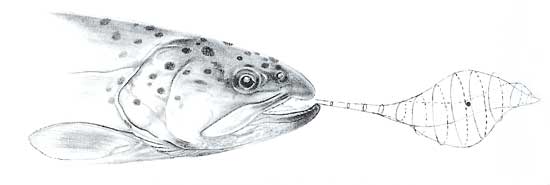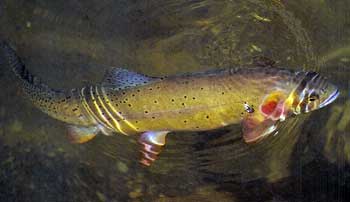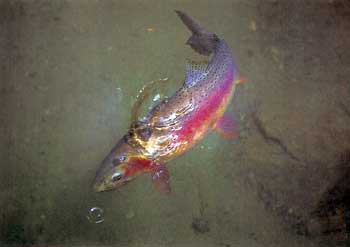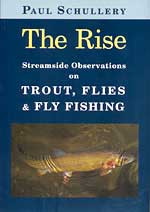Trout: Coping with Rejection
IF YOU’VE BEEN FISHING even a few years, you’ve watched a trout come up to your fly, give it a look, and turn away. That kind of rejection is discouraging, but at least it’s a nice, simple message from the trout: “I don’t like this.” And at that point, you’re welcome to apply whatever combination of stream savvy, folklore, and science you can muster — to try a different fly, a different tippet, a different presentation, a different prayer, or a different fish.

The trout’s suction feeding typically pulls a double-tapered column of water into the mouth along with the prey. The suction column begins with a small diameter, as the mouth is barely open, and grows wider as the fish’s mouth opens. The prey, signified by the dot in the center of the column at its greatest diameter, is usually within a head length of the fish before suction begins. The taper of the column is steeper beyond the prey; the mouth closes faster than it opens to ensure that the prey does not escape. By the means of this suction, trout routinely “reach out” to grab their prey. But the suction is sometimes defeated by artificial flies because of the resistance of leader and line. Illustration by Marsha Karle, adapted from a diagram in J. L. van Leeuwen (1984).
But there are other kinds of rejection that we could barely even recognize until recently. And whether we knew it or not, these other rejections often sent a more promising message: “That was very close; try again.”
Anglers’ deliberations on how trout take — or miss — a fly have constituted one of the quirkiest little narrative traditions in the literature of fly fishing. In his otherwise presciently insightful book The Rod and Line (1849), British angling writer Hewett Wheatley calmly explained that because of their somewhat underslung mouths, grayling could take flies from the surface of the stream only by turning upside down, doing a kind of backward loop-the-loop each time they fed. Imagine.
Not many years later, in 1878, a controversy raged for some weeks in the pages ofForest and Stream magazine over whether trout, conducting a similarly circular acrobatic maneuver, knocked flies into their mouths with their tails. One correspondent, the prominent New York angler George W. Van Siclen, reported that he routinely witnessed precisely this behavior on his local trout stream. So agitated were the angling community’s commentators by such claims that several of the sport’s biggest guns, including the famous fishing writers and fisheries authorities Charles Orvis, Reuben Wood, Seth Green, and Theodatus Garlick, weighed in with either pronouncements on why such a thing was silly or theories on what Van Siclen might have seen instead of what he thought he saw.
 The problem with all such theorizing is the problem encountered by students of the rise already mentioned: The trout’s take happens so fast that theorizing was all these people could do. As Forest and Stream editor Charles Hallock put it while moderating the tail-slapping debate, anyone who claims to have seen the take in such detail “must possess an electric quickness of vision.”
The problem with all such theorizing is the problem encountered by students of the rise already mentioned: The trout’s take happens so fast that theorizing was all these people could do. As Forest and Stream editor Charles Hallock put it while moderating the tail-slapping debate, anyone who claims to have seen the take in such detail “must possess an electric quickness of vision.”
Some people did in fact have a remarkably good eye for trout behavior. Others had an equally good intuitive sense of how trout actually do feed. But it wasn’t until the past forty or so years, as scientists began applying the photographic technology that really gave us “an electric quickness of vision,” that human observers have fully analyzed and appreciated the incredible subtlety of the trout’s take.
What science has shown us is fascinating and perhaps revolutionary, but we fishermen are still catching up. Consider this: As recently as 1980, a respected fishing writer could say that to take a fly, the trout “simply opens its gill covers and its gills, lets the current flow through, and the hapless insect is trapped in its gills or throat. Of course, some fish pick a fly from the surface with a rapier-quick thrust or a vertical sipping rise, but these riseforms are more common with small insects or spent flies.” This summary, though probably “common knowledge” among fishermen only
twenty years ago, is now known to be so inaccurate as to compete with Wheatley’s and Van Siclen’s theories as fantasy biology.
The Hands of the Trout
Half a century ago, in his immensely practical book How to Fish from Top to Bottom(1955), fisheries manager Sid Gordon made a telling observation that probably stuck with lots of his readers:
An angler should always remember that a fish has no hands. If he sees no enemy around, and something comes floating down with the current before his eyes, he seizes it with the only means in his power, his mouth. If it’s food, he accepts it. If he judges it inedible, he shoots it out of his mouth as if it were jet propelled.
Gordon was right and wrong about the hands. Biologically, it’s true that fish don’t have them. But physiologically, they’ve come up with a really helpful substitute. It’s odd that Gordon didn’t seem to realize that his hands analogy could have been carried a little further. His remark about the fish’s amazing ability to eject something from its mouth reveals some awareness of the natural valve system that makes up its head. In fact, the object was jet propelled.
Many scientific studies have examined suction feeding in fish. In the early 1980s, Johan van Leeuwen published a series of papers relating to this process in trout. In a study whose methods were as elegant as its analyses, he used high-speed motion-picture cameras to “map” the flow of fluid through the head of a feeding trout. If you are scientifically trained (physics of fluids would be especially helpful), you may enjoy reading the original publication. Besides learning to pronounce such charming words as ‘actinopterygian,’ you become immersed in the fabulously complex world that exists in a trout’s mouth, where rotational symmetries, vorticity distributions, leak currents, backwashes, maximal opercular abductions, and many other forces and wonders stir your imagination. But in mercy to most readers, I shall summarize just a few of his findings here.
The trout can exert an uncanny amount of control and precision in using suction. This is not just an indiscriminate vacuuming operation that sucks in whatever is nearby. As circumstances require, the trout can open or close its mouth at the right instant and to the right extent to tighten the focus of the suction, thus increasing both the intensity and reach of the pull. The fish often needs to do this, and it constantly makes many decisions about such things as it goes about its day. Suction is a very versatile tool.
The accompanying diagram portrays the general shape of the elongated column of water that is pulled into and through the trout’s head in the process of feeding. The column’s gradual increase in diameter and more abrupt decrease in diameter at its forward end indicate that the mouth opens more slowly than it closes. It is this rapid closing of the mouth that has led many writers to describe the fish as grabbing the fly as its mouth slams shut. In fact, the fly is already in the mouth, which closes rapidly to make sure it stays there. The suction already did the grabbing.
The diagram suggests the rough maximum distance at which a trout attempts to suck in prey. The target of the suction is usually less than a head length distant from the trout, which can wait until the insect is very close before pulling it in, especially when feeding in calm water. My photographs suggest that most of the time, the trout I was watching didn’t engage the “tractor beam” to a significant degree until the flies were almost to their lips.
Precisely when the trout begins the suction is very hard to determine with casual photographs, however. Even with their mouths open only slightly, the trout I photographed could have been applying considerable suction. And as I mentioned in chapter two, I suspect that a trout may also employ tiny jets of water in or out of its mouth to slightly manipulate and examine a potential prey item before applying its more forceful suction-feeding mechanism.
Trout have been using these “hands” for millions of years. Individual trout do it tens of thousands of times in their lives; they live by it practically from hatching until they die. They are, in short, experts.
Misses
Studying my photographs and then exploring the sizable technical literature on suction feeding sent me on an unsentimental journey back through the memories of more than thirty years of rises to my dry flies when the fish were not hooked — and because of my so-so fly-fishing skills, I have a very large personal database of such memories to evaluate. I recall myself saying again and again that comforting mantra of the fisherman who doesn’t understand what just happened: “He missed it!” Or just as frequently, I would say, “He hit it!” or “He had it!”
But now, looking back with somewhat more educated eyes, I doubt all that. These fish are too good at what they do to have missed as often as I thought they did. As satisfying as it might have been to think the fly was missed because of the fish’s incompetence, I just couldn’t buy that anymore.

My first interpretation of this photograph was that it showed a trout taking one fly while another slipped by. But I now suspect it shows a missed rise or, more likely, last-minute rejection. As the mayfly spinner passes over the trout’s pectoral fin, judging from the angle of the trout’s eye, the fish is watching the fly go — and perhaps considering another try at it.
The scientific literature of predation contains many summaries of the success rate of various predators, and some of those are fairly low, especially in the case of a large mammal, which may have to engage in quite a few chases in order to bring down one prey animal that will feed it for several days. The stakes are high all around in cases like that. But the success rate of one predator tells us very little about the success rate of another, especially if their needs, prey, and methods are dramatically dissimilar.
Could all those trout I missed really have been that lousy at their jobs? Could they miss so often? Well, we do know a rising trout has some challenges to overcome. First, there’s the trick of feeding on the surface of the water. Both Van Leeuwen’s study and his diagram of the column of water that is sucked in by the trout are based on fish feeding under the surface.
I’ve seen no study that tries to model the much more complicated physics and geometry of that suction column as it passes from one medium (water) to another (air). So I cannot give you a corresponding diagram of the suction column as it applies to a trout’s attempt to suck in a dry fly. But my photographs, inconclusive as they may be as diagrams of that passage of the suction from air to water, certainly show that much of the force of the suction is dissipated in pulling a broader disk of water down toward or into the fish’s mouth. That magnitude of distortion of the fish’s suction column would seem to greatly reduce the efficiency of the suction mechanism. This could make it a little harder to nail the prey, especially under otherwise marginal circumstances.
Thanks to a century of painstaking observation and analysis by the great dry-fly writers, we have learned that a fish taking a fly from the surface of the water is dealing with a complex set of visual variables that complicate its perception of any surface food it’s trying to take. A rippled surface, the refraction of light as it passes from air to water, and all the other subtle wonders relating to what the trout sees that many of our greatest angling theorists have pondered no doubt increase the likelihood of a missed rise.
But for all those complications, the trout has had millions of years of evolutionary preparation for just this moment. And it’s a veteran of thousands of similar feeding episodes in which it neatly sucked flies down from the surface of the stream. Even with floating prey, the trout is still an expert.
The scientific literature on predation is full of calculations of predation rates of various species. None always score, and some miss a lot more than they catch. Yellowstone’s famous wolves, for example, successfully kill an elk in only about one of every five chases. If trout never missed, they would be the only animals that don’t. But they’re not cheetahs trying to run down gazelles; they’re big fish sucking helpless little bugs off the surface of the water. They have too much going for them to miss very often.
So I realized it was likely that most of the time when I’d yelled, “He missed it,” though I had indeed missed the trout, the trout probably hadn’t missed the fly. Something else had occurred. The trout decided not to eat the fly at the last instant during the rise or took it and rejected it before I knew what happened. Or perhaps the fish never intended to take it and just came up for a splashy closer look.
Nature is very good at tuning up wild animals to do what they do and does this in a fairly brutal way. The most surefooted mountain goat may some day make that one fatal misstep it always seeks to avoid. But the odds are that before it does, it will have made several million competent, life-preserving, and entirely successful steps.












